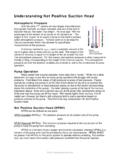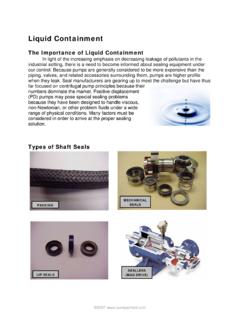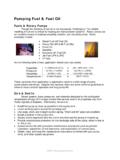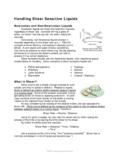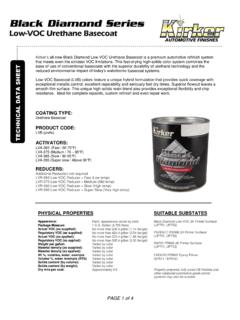Transcription of Pumping High Temperature Liquids - Pump School
1 Pumping high Temperature Liquids high Temperature Applications high Temperature applications can be found in nearly every industry, making an understanding of how to handle them critical. Use of a standard or stock pump on a high Temperature application may lead to leaking seals, stalled drives, or even break the pump. There are a number of reasons why a liquid needs to be handled at a high Temperature : Description Examples Room Temperature Solids Liquids which are solid or semi-solid at ambient Temperature which are heated to permit them to be moved more easily or to be applied, spread, processed, or otherwise utilized. Asphalts Molasses Roofing Tar Sulfur Lead Heat due to Process Liquids which are a process by-product or are being used in a product that uses heat as a catalyst to initiate, sustain, accelerate, or complete a reaction.
2 Soybean Processing Refineries (Cracking, Distilling) Asphalt Blending and Mixing Polymer Production (Styrene) Liquids used to Transfer Heat Liquids used to transfer heat to equipment such as: Plastic Molders Snow Removal Equipment Food & Candy Making Equipment Chemical Pumps and Equipment Dowtherm (Dow Chemical) Theminol (Monsanto) Mobiltherm (Exxon Mobil) The process temperatures for each of the example Liquids above vary widely. For simplicity sake, the remainder of this document will regard high Temperature applications to be those that exceed 225 F (110 C). While this document is intended to cover all Rotary PD Pumps, much of the following will describe Internal Gear Pumps specifically as these pumps have one of the highest Temperature limits, handling Liquids through 750 F (400 C). Pump Externals External metal parts are considered to be those that are in contact with the liquid on the inside and exposed to ambient conditions on the outside.
3 Selection of suitable metal of external pump construction will depend on the following: Dimensional changes due to thermal expansion Resistance to corrosion (typically, heat increases a Liquids corrosiveness) Maximum practical Temperature limit for use in PD pumps as determined by thermal shock resistance, loss of strength, or other factors 2007 Thermal shock occurs whenever sudden changes in the Temperature of the metal take place. Examples include spraying water on a pump handling hot oil during cleanup or letting preheated liquid into a cold pump on start-up. Thermal shock can cause pump externals to crack and should always be avoided. Cast Iron, while commonly used in pumps handling hot Liquids , is typically limited to 650 F (345 C) maximum, due to its relatively low thermal shock resistance. Low Carbon Cast Steel however, has very high thermal shock resistance, and is rated to 800 F (425 C) maximum.
4 External pump materials are not the only consideration for handling high Temperature Liquids . One must also consider the pump s internal construction. Pump Internals Generally, the selection of internal materials is based on the same considerations as those involved in the selection of the external materials. The emphasis on importance shifts slightly however. Thermal shock for example, becomes less of a concern. Thermal shock of the internals is less likely as ambient sources do not come into direct contact with them (like the sprayed cleaning water example above). For this reason, even steel external pumps will often have cast iron gears even for applications above the 650 F (345 F) practical limit described above. This does NOT however rule out internal shock sources (like the cold start-up example above) so steel and hardened steel internals are sometimes utilized.
5 Loss of hardness plays a very serious role in internal material selection. Induction hardened steel idler pins for example tend to lose their hardness at elevated temperatures . Nitrided steel idler pins (Nitralloy) retain their hardness over the full Temperature range. For this reason, Nitralloy pins are used for high Temperature applications beyond 450 F (230 C). Dimensional change due to thermal expansion plays an enhanced role on two fronts. 1) Clearances in the pump are critical to pump operation and maximum efficiency. Heat causes the metal parts to expand, decreasing the internal clearances. Extra clearances must be added to insure that the pump does not seize due to this thermal growth. Figure 1 Head and Pin Assembly (red arrows indicate thermal expansion) 2) These thermal expansion rates vary from material to material. While steel and tungsten carbide are each capable of withstanding temperatures through 800 F (425 C), a tungsten carbide pin pressed into a steel head will be rated to much less.
6 Steel has a higher coefficient of thermal expansion than tungsten carbide and as such, the fit between these parts loosens at elevated t(figure 1). Similarly, idler/bushing assemblies nechecked as well. This assembly Temperature liwill depend on the materials of each componenwell as the part dimensions (both overall size andfit). emperatures ed to be mit t as 2007 Sealing liquid containment is always a concern, but when h750 F (400 C), it becomes even more critical. MechanFigure 2 Cartridge Mechanical Seal for Handling Heat Transfer Oil Photo courtesy of PPC Mechanical Sealsandling Liquids upwards of ical seals are most commonly used for the ually leak-free, which saves product, reduces stment te shaft wear he application conditions. Seal materials need to be pable of withstanding the maximum Temperature . liquid being ne graphite and a such maintenance required ump on high Temperature liquid faces unique are typically limited to about 500 F (260 C).
7 T and s following reasons: They are virtmesses, and reduces operator exposure risk. They do not require frequent attention and adju They do not require outside lubrication They elimina They are easy to replace Seal selection will vary based onompatible with the liquid and ca tcFlushing or quenching the seal (providing liquid to the outside of the seal) may be used to cool the seal faces or prevent residue buildup. Seal placement is also a consideration. Often by placing the seal further down the shaft, away from the Pumping chamber, the Temperature is kept as much as 100 F (40 C) cooler than the pumped. Packing is commonly used as well and is typically used for the following reasons: liquid characteristics make sealing with mechanical seals difficult Packed pumps are less prone to catastrophic seal failure Packing is typically more economical Standard packing is typically braided expanded PTFE with ultrafimineral oil lubricant.
8 It is suitable for a wide range of applications, but is typically limited to less than 450 F (230 C). For higher temperatures there are several alternatives as compressed graphite or metallic packing. Magnetically coupled pumps are sometimes uses as well and offer the following benefits: Zero leakage of product or odor No No lubrication required Running a magnetically coupled pchallenges however. First of all, they Secondly, the rare earth magnets used to couple the pump get weaker with heamust be derated to accommodate the load. And finally, magnetically coupled pumpare also typically more expensive than their sealed or packed counterparts. Often thebenefits outweigh the challenges, especially for hard to seal, expensive, or hazardousliquids. 2007 Figure 3 Jacketed Heavy-Duty Internal Gear Pump Photo courtesy of Viking Pump, Inc.
9 Eans of Heating the Pump he reasons for handling Liquids at high mp. Materials such as asphalt, molasses, sulfur, r signed to have steam or hot oil circulated throug d in n be heavy insulation is applied to the pumpto help Temperature throughout the system before starting the pump. ns are the identical so it s critical to gather all of the details . Pump sizing, material selection, seal selection, etc. all depend on the Photo courtesy of Viking Pump, Inc. eans of Heating the Pump he reasons for handling Liquids at high mp. Materials such as asphalt, molasses, sulfur, r signed to have steam or hot oil circulated throug d in n be heavy insulation is applied to the pumpto help Temperature throughout the system before starting the pump. ns are the identical so it s critical to gather all of the details . Pump sizing, material selection, seal selection, etc.
10 All depend on the MMAs mentioned in the introduction, one of ttemperatures is that they are easier to puAs mentioned in the introduction, one of ttemperatures is that they are easier to puchocolate, tar, wax, and #6 fuel oil are either solid at ambient temperatures or soviscous that it is impractical to try to pump them without heating. If a pump is used fohandling such Liquids and is permitted to stand idle, the liquid will cool and the pump will be impossible to start without heating the liquid . That isn t to say that users don t try, resulting in kicked out motor starters, stripped reducer gears, slipping v-belts, or even broken pump parts. A pump with jacketing is normally recommended for this type of application. Jacketed pumps have cavities integral to the pump which are dechocolate, tar, wax, and #6 fuel oil are either solid at ambient temperatures or soviscous that it is impractical to try to pump them without heating.
